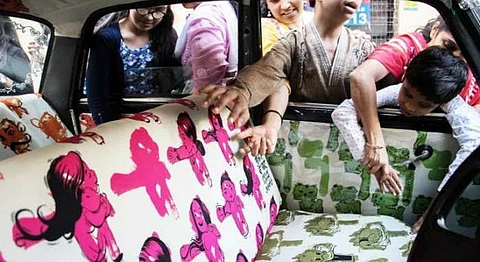
- HOMEGROWN WORLD
- #HGCREATORS
- #HGEXPLORE
- #HGVOICES
- #HGSHOP
- CAREERS
- ABOUT US
- CONTACT US

For so many people the kaali peeli taxis are woven into the genetic code of what makes Mumbai, Mumbai. But today there is one taxi out there that outshines the all the rest. From a truly inspirational collaboration between See Now, design project Taxi Fabric, and artist Jezreel Nathan, comes a one-of-a-kind taxi that will open your eyes to the struggles of the visually impaired.
Their mission was to educate people on the prevalence of avoidable blindness. It’s a reality that, in India, 4 out of 5 people living with blindness can actually be cured with corrective surgery. The lack of facilities and financial support is the only thing holding them back from living an easier life and Taxi Fabric wanted to use art to take this message to the world. To create the design, Jezreel worked with blind and visually impaired children. They were each given a word and asked to paint what they thought that word would look like. Due to their lack of sight, most painted an abstract shape which Jezreel overlaid with more recognisable forms of the word but she left every fifth shape as it was to represent the one incurable case out of the five.
This beautiful project is shedding light on an issue that few people even knew existed. With colour and joy, they are showing people that so many are needlessly suffering and it’s about time something was done to restore their lives.
We caught up with Jezreel to learn more about her experience.
Homegrown: Tell us about the experience of working with children on the design?
Jezreel Nathan: I learned so much from these children. It was an overwhelming experience. Even though I knew I was working with visually impaired children, it took time for it to sink in before I could alter my behaviour to be more sensitive to their needs. There were times that I would move from assisting one child to another only to realise that the first child didn’t know I was gone because she didn’t see me leave and I would suddenly hear her shouting out my name and realised that I needed to tell her that was leaving and would return to assist her in a short while.
There were many instances that invoked a sense or gratitude for the ability to see and at the same time marvel at these kids who inspite of their impairment were so full of joy and enthusiastic about taking on the challenge of painting something they’d never seen. They sang songs and laughed and chattered while they painted and in the midst of this joyous chaos it became apparent that their other senses were so well developed, to the point that they literally relied on them.
Every area of their lives is affected by this impairment and is so far removed from the lives we live and know as normal. I tried putting myself in their shoes as I assisted them with paint or helped them find their way to the washroom or served them food and the feeling it left me with is so hard to put into words. I was overcome with helplessness, but I know there’s HOPE in the message that we’re trying to get across to people through this project.
HG: What part of the project was the most challenging and what was the most rewarding?
JN: Each stage of the project presented its own kind of challenges, but the most challenging part was taking over from where the children had left off. Just as they found it challenging to paint things they’d never seen, it felt like I too was in the dark trying to visualise tangible and more recognisable forms of the words they were given in the splotches of colour they had painted and create something more realistic from something abstract.
The most rewarding part is looking back on the evolution of this approach as my proposed design solution for the Taxi; Right from planning the workshop to making the artworks, there were times when I felt like I had control and knew exactly what the final execution would look like and then at every turn I was faced with uncertainty.
For me, being faced with so much more uncertainty than I’m used to while working on a project, helped me value and really glean from every part of the process that went into making this Taxi and it also helped me appreciate, acknowledge and trust the role of the unknown in the final outcome of this project.
HG: If you had one message for the audience of this project, what would it be?
JN: When I was briefed for this project and was told about the message we were to convey, that 4 out of 5 people who are visually impaired can have their sight restored through corrective surgery, my initial reaction was that of surprise and disbelief. Every time I speak about this message to friends and family they also have the same reaction. It seems too good to be true, and it is true. So most importantly I would urge everyone to share this message, this project and this Hope. Secondly I would like to urge everyone to practice gratitude.
